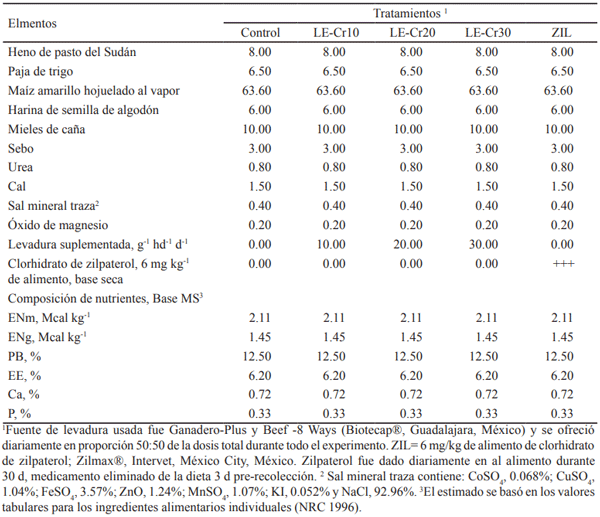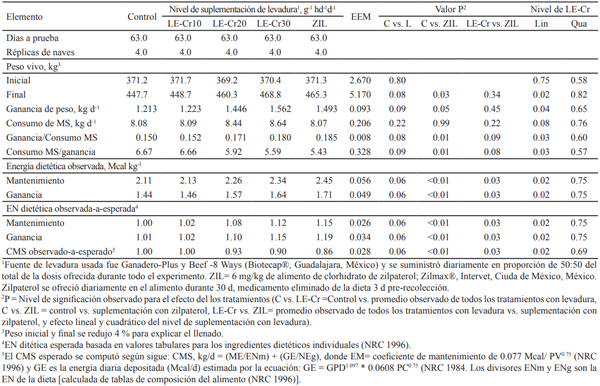Comportamiento del crecimiento y características de la canal de novillas en lote seco alimentadas con diferentes niveles de levadura viva enriquecida con cromo o con clorhidrato de zilpaterol
Yissel S. Valdés-García1 , J.I. Aguilera-Soto2 , A. Barreras1 , A. Estrada-Angulo3 , A. Gómez-Vázquez4 , A. Plascencia1 , F.G. Ríos3 , J.J. Reyes5 , J. Stuart5 y Noemí G. Torrentera1 1 Instituto de Investigaciones en Ciencias Veterinarias, Universidad Autónoma de Baja California, Mexicali 21100, Baja California, México. 2 Unidad Académica de Medicina Veterinaria y Zootecnia, Universidad Autónoma de Zacatecas, El Cordovel Enrique Estrada, Zacatecas, 98500, México. 3 Facultad de Medicina Veterinaria y Zootecnia, Universidad Autónoma de Sinaloa, Culiacán 1084, Sinaloa, México. 4 División Académica de Ciencias Agropecuarias, Universidad Juárez Autónoma de Tabasco, km 25 Villahermosa-Teapa, Tabasco, México 5 Departamento de Rumiantes, Instituto de Ciencia Animal, km 47.5 Carretera Central, Mayabeque, Cuba.
Se utilizaron sesenta novillas cruzadas (371 ± 7 kg) en una prueba de alimentación de 63 días de duración (4 naves por tratamiento en un diseño de bloque completamente al azar) para evaluar la influencia del suplemento dietético con clorhidrato de zilpaterol (β-agonista) o con diferentes niveles de levadura viable enriquecida con cromo (LE-Cr) en el crecimiento y las características de la canal. La novillas se alimentaron con una dieta basada en maíz hojuelado al vapor (1.45 Mcal de energía neta de ganancia, ENg kg-1). Los tratamientos fueron: 1) control, sin levadura, sin suplemento de zilpaterol (Ctrl); los tratamientos 2, 3 y 4) contenían la misma dieta basal suplementada con LE-Cr comercial para una dosis final de 10, 20, ó 30 g hd-1 d-1 de cepa de levadura, y 5) la misma dieta basal (Ctrl) suplementada con 6 mg de zilpaterol kg-1 de alimento durante 30 d (ZIL), medicamento que fue eliminado de la dieta 3 d antes de la recolección. Comparado con los controles, el zilpaterol incrementó el peso final (3.8 %, P < 0.03), la ganancia diaria ajustada a la canal (18.7 %, P = 0.05), la energía de mantenimiento aparente neta (14 %, P < 0.01), y disminuyó la relación del CMS observado/esperado (14 %, P < 0.01). El tratamiento con zilpaterol (β-agonista) no influyó (P < 0.13) en el nivel de marmoleo, pero, comparado con el grupo control, incrementó el rendimiento de la canal (2.6 %, P = 0.01), y redujo (P = 0.02) la grasa de los riñones, la pelvis y el corazón (RPC, 19.8 %) y el grosor de la grasa (9.4 %) y tendió (5.9 %, P = 0.06) a incrementar el área del músculo Longissimus dorsi. Comparado con los tratamientos con LE-Cr, el zilpaterol incrementó la ENm aparente dietética (P = 0.03) y el rendimiento de la canal (P < 0.01), y disminuyó la relación del CMS observado/esperado (P = 0.03) y la grasa de RPC (P=0.04). El tratamiento con LE-Cr no influyó en las características de la canal, pero comparado con el control, el suplemento de LE-Cr tendió a incrementar el PC final (P = 0.08), GPD (0.09), la tasa consumo:ganancia (C:G, P = 0.08) y la EN dietética (P = 0.06). El nivel de suplemento de LE-Cr incrementó (componente lineal, P ≤ 0.04) el PC final, la GPD, la tasa consumo:ganancia, la ENm aparente dietética, y disminuyó (P = 0.02) la tasa del CMS observado/esperado. El nivel de LE-Cr del suplemento no afectó (P ≥ 0.33) el rendimiento de la canal, el área del músculo Longissimus dorsi o el nivel de marmoleo, pero disminuyó el grosor de la grasa y la grasa de RPC (P = 0.02) a medida que se incrementó el nivel de suplemento de LE-Cr. El CMS y el peso de la canal caliente tendieron (P ≤ 0.08) a incrementarse con el aumento del nivel de suplemento de LE-Cr. Se concluye que el suplemento de zilpaterol mejoró el crecimiento en novillas como resultado de mayor crecimiento muscular y reducción de la grasa corporal. El suplemento de levadura enriquecida con cromo aumentó el crecimiento y la EN dietética, con efecto modesto en las características de la canal. Se observaron mejores respuestas con el nivel de suplemento de LE-Cr de 30 g hd-1 d-1 que corresponde a consumos diarios de 1.65 × 1011 unidades formadoras de colonia y 15 mg de cromo.
Palabras clave: ganado de finalización, β-agonista, microorganismos alimentados de forma directa, eficiencia alimentaria, rasgos de la canal.



AOAC. 2000. Ass. Off. Anal. Chem . Official Methods of Analysis (17th Ed). Gaithersburg, MD, USA
Avendaño-Reyes, L., Torres-Rodríguez, V., Meraz-Murillo, F.J., Pérez-Linares, C., Figueroa-Saavedra, F. & Robinson, P.H. 2006. Effects of two β-adrenergic agonists on finishing performance, carcass characteristics, and meat quality of feeddlot steers. J. Anim. Sci. 84:3259
Barajas, R., Cervantes, B. J., Velazquez, E.A., Romo, J.A., Juarez, F., Rojas, P.J. & Peña, F.R. 2008. Chromium methionine supplementation on feedlot performance and carcass characteristics of bulls: II. Results including trough hot and humidity season in the northwest of Mexico. Proceeding of West Section of American Society of Animal Science, USA. 59:374
Block, H. C, McKinnon, J.J., Mustafa, A.F. & Christensen, D.A. 2001. Manipulation of cattle growth to target carcass quality. J. Anim. Sci. 79:133
Chang, X. & Mowat, D.N. 1992. Supplemental chromium for stressed and growing feeder calves. J. Anim. Sci. 70: 559 Cole, N.A., Purdy, C.W. & Hutcheson, D.P. 1992. Influence of yeast culture on feeder calves and lambs. J. Anim. Sci. 70: 1682
Council of the European Communities.1986. Council Directive 86/469/EEC of 16 September 1986. Off. J. Eur. Commun. L275:36
Dawson, K.A., Newman, K.E. & Boling, J.A. 1990. Effects of microbial supplements containing yeast and lactobacilli on roughage-fed ruminal microbial activities. J. Anim. Sci. 68: 3392
Domínguez-Vara, I.A., González-Muñoz, S.S., Pinos-Rodríguez, J.M., Bórquez-Gastelum, J.L., Bárcena-Gama, R., Mendoza- Martínez, G., Zapata, L.E. & Landois-Palencia, L.L. 2009. Effects of feeding selenium-yeast and chromium-yeast to finishing lambs on growth, carcass characteristics, and blood hormones and metabolites. Anim. Feed Sci. Technol. 152:42
Elam, N.A., Vasconcelos, J.T., Hilton, G., VanOverbeke, D.L., Lawrence, T.E., Montgomery, T.H., Nichols, W.T. Streeter, M.N., Hutcheson, J.P., Yates, D.A. & Galyean, M.L. 2009. Effect of zilpaterol hydrochloride duration of feeding on performance and carcass characteristics of feedlot cattle. J. Anim. Sci. 87: 2133
FDA. 2006. Freedom of information summary original new animal drug application. NADA 141-258. Zilmax (zilpaterol hydrochloride) Type A medicated article for cattle fed in confinement for slaughter. Disponible: <http://www.fda.gov/cvm/FOI/141-258o08102006.pdf> [Consultado: Noviembre 2010]
Garrett, W. 1971. Energetic efficiency of beef and dairy steers. J. Anim. Sci. 31:452
Haddad, S. G. & Goussous, S.N. 2005. Effect of yeast culture supplementation on nutrient intake, digestibility and growth performance of Awassi lambs. Anim. Feed Sci. Technol. 118, 343
Holland, B.P., Krehbiel, C.R., Hilton, G.G., Streeter, M.N., VanOverbeke, D.L., Shook, J.N., Step, D.L., Burciaga-Robles, L.O., Stein, D.R., Yates, D.A., Hutcheson, J.P., Nichols, W.T. & Montgomery, J.L. 2010. Effect of extended withdrawal of zilpaterol hydrochloride on performance and carcass traits in finishing beef steers. J. Anim. Sci. 88: 338
Jackson, A.R., Powell, S., Johnston, S.L., Matthews, J.O., Bidner, T.D., Valdez, F.R. & Southern, L.L. 2009. The effect of chromium as chromium propionate on growth performance, carcass traits, meat quality, and the fatty acid profile of fat from pigs fed no supplemented dietary fat, choice white grease, or tallow. J. Anim.Sci. 87:4032
Johnson, B. J. & Chung, K.Y. 2007. Alteration in the physiology of growth cattle with growth-enhancing compounds. En: Veterinary Clinics of North America: Food Animal Practice. Vol. 23. Hollis L.C. & Olson, K.C. Ed. W.B. Saunders Co. Philadelphia, PA, p 231
Kellems, R. O., Lagerstedt, A. & Wallentine, M.V. 1990. Effect of feeding Aspergillus oryzae fermentation extract or Aspergillus oryzae plus yeast culture plus mineral and vitamin supplement on performance of Holstein cows during a complete lactation. J. Dairy Sci. 73:2922
Kellermeier, J.D., Tittor, A.W., Brooks, J.C., Galyean, M.L., Yates, D.A., Hutcheson, J.P., Nichols, W.T., Streeter, M.N., Johnson, B.J. & Miller, M.F. 2009. Effects of zilpaterol hydrochloride with or without an estrogen-trenbolone acetate terminal implant on carcass traits, retail cutout, tenderness, and muscle fiber diameter in finishing steers. J. Anim. Sci. 87: 3702
Krehbiel, C. R., Rust, S.R., Zhang, G. & Gilliland, S.E. 2003. Bacterial direct -fed microbials in ruminant diets: Performance response and mode of action. J. Anim. Sci. 81:E120
Montgomery, J. L., Krehbiel, C.R., Cranston, J.J., Yates, D.A., Hutcheson, J.P., Nichols, W.T., Streeter, M.N., Swingle, R.S. & Montgomery, T.H. 2009. Effects of dietary zilpaterol hydrochloride on feedlot performance and carcass characteristics of beef steers fed with and without monensin and tylosin. J. Anim. Sci. 87: 1374
Moody, D. E., Hancock, D.L. & Anderson, D.B. 2000. Phenethanolamine repartitioning agents. En: Farm Animal Nutrition. D’Mello, J. P. F. Ed. CABI Publishing, New York, NY, p 65
Morris, T.R. 1999. Experimental Design and Analysis in Animal Sciences. Ed. CABI Publishing, New York.
Murdoch, G. K., Okine, E.K. & Christopherson, R.J. 2005. Metabolic modifiers in animal nutrition: potential benefits and risks. En: Biology of Nutrition in Growing Animals. Vol. 4. Mosenthin, R., Zentek, J. & Zebrowska, T. Ed. Elsevier. Philadelphia, PA, p 135
Neill, S., Unruh, J.A., Marston, T.T., Jaeger, J.R., Hunt, M.C. & Higgins, J.J. 2009. Effects of implanting and feeding zilpaterol hydrochloride on performance, carcass characteristics, and subprimal beef yields of fed cows. J. Anim. Sci. 87: 704
Normas Oficiales Mexicanas. Diario Oficial de la Federación. Disponible <http://dof.gob.mx/ > [Consultado: Noviembre 2009]
NRC. 1984. Nutrient Requirements of Beef Cattle. 6th Rev. Ed. Natl. Acad. Press, Washington, DC.
NRC. 1996. Nutrient Requirements of Beef Cattle. 7th Rev. Ed. Natl. Acad. Press, Washington, DC.
Plascencia, A., Torrentera, N. & Zinn, R.A. 2008. Influence of the B-agonist, zilpaterol, on growth performance and carcass characteristics. J. Anim. Vet. Adv. 7:1257
Plascencia A. & Zinn, R.A. 2002. Evaluation of a forage-fat blend as an isocaloric substitute for steam-flaked wheat in finishing diets for feedlot cattle:growth-performance and digestive function. Prof. Anim.Sci.18:247
Robles-Estrada, J.C., Arrizon, A. Calderon-Cortés, J.F., Figueroa-Saavedra, F., Torrentera, N., Plascencia, A. & Zinn, R.A. 2009. Effects of pre-harvest withdrawal period on response of feedlot heifers to zilpaterol hydrochloride supplementation: Growth performance and carcass characteristics. J. Anim. Sci. 87:1759
Romero, M., Pinos-Rodríguez, J.M., Herrera, J.G., García, J.C., Salem., A.Z.M., Bárcena, R. & Alvarez, G. 2009. Influence of zilpaterol and mineral-yeast mixture on ruminal fermentation and growth performance in finishing steers. J. Appl. Anim. Res. 35:77
Swanson, K.C., Harmon, D.L., Jacques, K.A., Larson, B.T., Richards, C.J., Bohnert, D.W. & Paton, S.J. 2000. Efficacy of chromium-yeast supplementation for growing beef steers. Anim. Feed Sci. Technol.86:95
USDA. 1965. Official United States Standards for Grades of Carcass Beef. C&MS, SRA 99
Vasconcelos, J.T., Rathmann, R.J., Reuter, R.R., Leibovich, J., McMeniman, J.P. Hales, K.E., Covey, T.L., Miller, M.F., Nichols, W.T. & Galyean, M.L. 2008. Effects of duration of zilpaterol hydrochloride feeding and days on the finishing diet on feedlot cattle performance and carcass traits. J. Anim. Sci. 86: 2005
Zinn, R.A., Alvarez, E.G., Rodriguez, S. & Salinas, J. 1999. Influence of yeast culture on health, performance and digestive function of feedlot steers. Proc. West Sect. Am. Soc. Anim. Sci. 50:335













